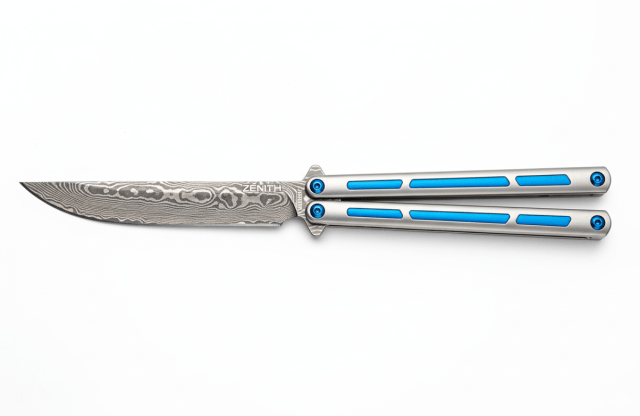
Introduction
In the diverse world of knives, few designs command as much attention or fascination as the butterfly knife. Known officially as a balisong, this unique tool is famous for its intricate, fan-like opening. This isn’t a simple spring-loaded mechanism; it’s a process achieved through a series of complex and often flashy hand movements. This art, known by its practitioners as “flipping,” has created a global subculture, turning the knife from a simple utility tool into a high-octane, skill-based hobby. However, this visual flair, often highlighted in movies, is also met with significant misunderstanding and legal confusion. For anyone interested in this captivating tool, a proper guide to butterfly knives is essential. It’s a journey into a tool that is part utility, part performance art, and entirely unique.
What is a Butterfly Knife (Balisong)?
At its core, a butterfly knife is a type of folding pocketknife, but its genius lies in its simple and strong construction. What sets it apart is its handle. Instead of a single handle that the blade folds into, a balisong has two separate handle segments that rotate independently on pivots. When the knife is closed, these two handles swing together to completely conceal the blade within a channel. To open it, the user manipulates these two handles, which counter-rotate and swing around. They eventually meet and lock together in the user’s hand, forming a solid grip and exposing the blade. This design is strong because the user’s own grip provides a structural lock. The two handles are known as the “safe handle” (the one that doesn’t have the blade’s sharp edge on its side) and the “bite handle” (the one that does, and which can “bite” a careless flipper). Learning to tell them apart is the first step for any new flipper.
The Art of “Flipping”
This unique opening mechanism is what makes the butterfly knife famous. The process of opening and closing it is not just a simple flick; it’s a performance. “Flipping” is a recognized skill hobby that involves passing the knife through an almost limitless series of spins, twirls, catches, and intricate hand movements. These “tricks” range from simple, fast openings like the “Zen Rollover” to highly complex, non-stop aerial combinations that are mesmerizing to watch. This hobby requires significant practice, dexterity, and muscle memory. To make this practice safe, many people start with a “trainer.” A balisong trainer is a tool that has the exact same weight, balance, and construction as a real, “live blade” one, but the “blade” is just a solid, dull piece of metal. This allows new users to practice tricks and build muscle memory without any risk of cutting themselves. This practice-focused side of the knife is a huge part of its modern culture.
A Tool with a Tangled History
The exact origin of the balisong is a subject of much debate, which is a key part of any good guide to butterfly knives. Many historians and enthusiasts believe its roots are deep in the Philippines. There, “balisong” (often translated as “broken horn,” as handles were traditionally made of animal horn) was a common utility and self-defense tool, an everyday carry knife. The term “balisong” is also the name of a specific village in the Batangas province, which became famous for producing these knives. Another theory, however, suggests it may have originated in Europe, perhaps in France or Spain. This theory posits that the design was later brought to the Philippines via trade routes, where it was adopted and perfected. Regardless of its true origin, it was in the Philippines that the knife’s distinct culture and utility truly formed. It was then brought to the United States after World War II by soldiers returning from the Pacific, where its unique design and the emerging “flipper” culture led to its widespread reputation.
The Sharp Edge of the Law
Unfortunately, this knife’s unique appearance and its association with quick-draw “tricks”—often sensationalized in movies to be the weapon of choice for villains—have given it a very negative reputation in the eyes of the lawmakers. This is where butterfly knife laws become extremely important and incredibly confusing. In many countries, and in many U.S. states (like California and New York), the butterfly knife is heavily restricted or outright banned. It is often incorrectly classified as a “gravity knife” or a switchblade, even though it operates on a completely different mechanical principle (it relies on handle manipulation, not a spring). These butterfly knife laws can be confusing and vary wildly from one state to the next, and even from one city to another. What is perfectly legal to own as a collector’s item in one place might be a serious felony in another. This legal ambiguity is a major hurdle for hobbyists, making it essential to research your specific, local laws before purchasing one.
What to Look for in Your First Balisong
If you’ve checked your local laws and are ready to get into the hobby, choosing your first knife is a big step. A good starter knife should have a few key features. First, as mentioned, start with a trainer. Once you are ready for a live blade, consider the handle construction. “Sandwich” construction (where the handles are made of two separate pieces) is often easier to maintain, while “channel” construction (where the handle is one solid, milled piece) is often considered more durable. The pivots are the most important part; they determine how the knife “feels” and flips. You’ll want a knife with smooth-running washers or, for a higher-end model, bearing or bushing systems, as this makes flipping easier and more consistent. For those looking for a complete overview of all the different styles, from beginner trainers to high-end collector’s pieces, a comprehensive guide to butterfly knives can be an invaluable resource to help you make the right choice.
Conclusion
The butterfly knife is far more than just a simple blade. It is a masterpiece of mechanical design, a challenging skill toy, and a tool with a rich, debated history. It requires dexterity to use and dedication to master, which is why it has such a passionate and loyal community of followers. While its legal status can be complicated and its reputation in pop culture is often one-sided, a true guide to butterfly knives shows that its heart lies not in aggression, but in the art of motion, the joy of mastering a skill, and the pursuit of a unique hobby. It is a perfect blend of form and function that continues to captivate new generations.













